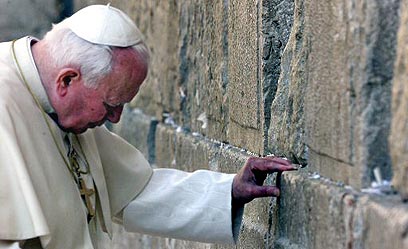
Pope visited Israel's Western Wall and Yad Vashem Holocaust Museum in 2000
Photo: Reuters
The strapping Polish seminarian gathered up into his arms the starving Jewish girl who had just been liberated from a Nazi forced labour camp.
Now, Edith Zierer, 74, remembers the warm look in Karol Wojtyla's eyes and on Saturday she mourned the death of the man who became Pope John Paul II.
"He was a kindred spirit in the greatest sense -- a man who could save a girl in such a state, freezing, starving and full of lice, and carry her to safety," she told Reuters. "I would not have survived had it not been for him."
Polish-born Zierer was 13 when she ran away from the Nazi camp at Czestochowa in Poland after the Soviet army liberated it in January 1945, five months before World War Two ended in Europe.
She was heading towards her home town in Poland to find her family, who she would later learn had died in the Holocaust. Exhausted, she reached a train station and sat there for two days without food or water while people ignored her.
"Suddenly, there he was," Zierer said, referring to Wojtyla. "He brought me some tea and two pieces of bread with cheese and then carried me to a train carriage. He sat with me and put his cloak on me because it was freezing."
"We came to Krakow and then I ran away because people started to ask why a priest was walking with a Jewish girl."
After spending a few years in orphanages in Poland and France, Zierer immigrated to British-mandated Palestine, where she later married and bore a son and daughter in what became Israel. She now has five grandchildren.
She wrote to Wojtyla after he became Pope in 1979, saying she was the little girl he had saved at the train station in Poland decades ago.
After a correspondence ensured, the Pontiff invited her to the Vatican in 1998. She last met him in 2000, when he visited Israel on a millennium pilgrimage and met several survivors at the Vad Vashem Holocaust museum.
"I did not cry at the Vatican but at Yad Vashem, I just burst into tears," she said.
She said she and the Pope kept up their correspondence, writing mostly during Christmas and before birthdays.
"I received a letter from him last year and I knew it was the last," she said. "He included a picture from his private collection and his handwriting was very shaky. I wrote to thank him for the memory that never left."















